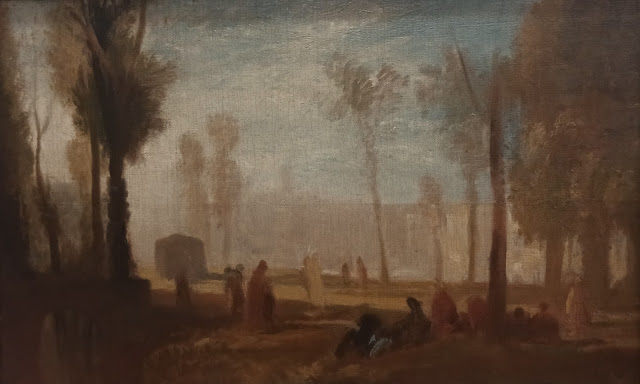This post is continuation of: Turner at Tate Britain – Turner's Britain
✲✲✲
Venice - Sunset, a Fisher (1845)
 |
| Venetian sunset. |
What is really interesting about this painting is that it pins Venice onto a background where – as with the first light of dawn – the distinction between the sky (and clouds) and the river water – from the right perspective – can meld and interfuse. Sunsets – when viewed from a certain level – can create such a beautiful illusion. Hauntingly so.
I think Turner’s sunsets have a dreamlike ethereality. Diaphanous and abstract.
Through the mist Turner foments in his painting, the intensity of the brown-rusty hue alludes to the solid structures of life. The brushstrokes of stoney-grey create tenuous forms: as the wind in its diffusive speed, or as some splotch in the water.
I think the sun can be just about be perceived on the right-hand side of the canvas from the epicentre of stillness. One can make out the Santa Maria della Salute against the blue skyline.
Beautiful.
✲✲✲
Venice - Noon (1845)
This painting forms a pair with the above Venice – Sunset, a Fisher. They both have similar tones, themes and colour palettes.
Both beautiful paintings of Venice.
✲✲✲
Riva degli Schiavone, Venice: Water Fête (1845)
 |
| Riva degli Schiavone. |
According to the Tate, Turner’s painting had the following lines from Byron’s poem:
… and now, fair Italy!
Thou are the garden of the world…
Thy wreck a glory, and thy ruin graced
With an immaculate charm which cannot be defaced.
This painting is interesting. It doesn’t feel like Britain at all. It certainly has a Mediterranean quality. We don’t have trees quite like that in England.
In this painting, Turner’s sun illuminates from the right and the warmth of colours dissipate outwards. There’s a profusion of orange-marigold colours. Since this is a tribute to Roman architecture and elegance, the crumbling bridge as well as the mossed over hovels (at the right) attest to the classicism and elegance of ancient Rome.
And, as usual, Turner includes children and families that speak to a quality of innocence, purity, and arcadian charm.
It really is a lovely vista.
A closer examination:
 |
| Nonchalantly sitting and chatting on a meadow overlooking a dilapidated breaking-up bridge. People seem oblivious to their surrounding beauty. The river slowly winding. Flowers surrounding the girls. |
✲✲✲
Heidelberg (1844)
 |
| Heidelberg |
This painting is a marriage between Princess Elizabeth Stuart (eldest daughter of King James I) and Friedrich V. (Elector Palatine of the Rhine in the Holy Roman Empire). Heidelberg castle is behind them on the hill. According to the Tate, “their court was briefly famous for its extravagant entertainments.”
The royal couple are seated in the left-hand corner of the painting.
Beautiful radiant sun whose sunshine commingles with the surrounding clouds, snowy mountain peaks, a valley from which jubilant crowds are coming forth. It’s a lovely painting.
Details:
 |
| A man bowing before the royal court. Military paraphernalia at the side. |
 |
| Castle that shimmers in the background. |
 |
| Musical instruments and smiles all round. |
✲✲✲
Caligula’s Palace and Bridge (1831)
I have to admit this was really breath-taking in the gallery. This is my favourite among the Europe gallery.
Although this painting is meant to invoke the decay of the glorious ancient Roman civilisation and Emperor Caligula, it captures a timeless beauty: the elegant columns that once held up a dome, the residual towers and fortification attest to a long-forgotten elegance, opulence and strength.
The former palace seems to meld into the canopy and trees as though it was part of the natural world. The sun seems to originate from behind the Roman structures and radiates outwards. The illumination creates a marvellous shimmering line on the lake and spotlights the two children sitting on the rock.
There is a sense of nostalgia and wistfulness about the painting. The people of the painting don’t seem to notice the wondrous pensive beauty surrounding them.
Plus, I quite like Caligula.
Details:
 |
| Two children. One with an arm around the other. Two sweet goats approaching with a herd behind them. Sea and ships in the distant. |
 |
| Looks like a shepherd is herding a few straggling goats away from the lake and towards the field. He’s looking at the two boys as they chase a pair of goats. |
 |
| The light gleams through the apertures and floods the environment. The Roman fortified buildings almost become one with the skyline otherwise they meld with surrounding vegetation. One with nature. |
✲✲✲
Rouen: A View from the Left Bank in the Faubourg St-Sever (1827)
According to the Tate: “Turner based this view of Rouen on a sketch he made while travelling in France several years earlier.”
This is quite different to the rest. Turner’s characters in the painting are overshadowed and we don’t seem to have as much energy.
✲✲✲
Dieppe: The Port from the Quai Henri IV (1827)
As with the above painting at Faubourg St-Sever, Turner doesn’t give us the warmth and opulence of the sun, so it feels a bit darker. But, it has the bustle of life and people going about their day. It’s hard to make out details but I don’t think we’re supposed to.
The structure of the bridge is beautiful. I think Turner likes bridges in his paintings too with a river flowing beneath it.







No comments:
Post a Comment